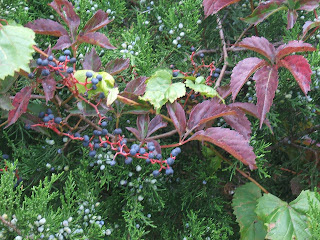







Today is the first day of Autumn, and I feel that I should write something to mark the change of the seasons. It was warm today and the ground is dry enough for July or August, but lots of plants are putting on a show. Maybe the various migrations have already begun, but I haven't seen any signs of them yet. I'll bet that the birds are fattening themselves up as fast as they can.
My friend Marie, whom I mentioned in my last post, plants flowers that attract hummingbirds to her property (red, bright pink, orange or purple tubular flowers), and she is still seeing hummingbirds in mid-September. The green herons haven't left yet. Today I saw one of the green herons that visit our pond, and as I watched, it caught a frog. I caught a photo! I hope you'll forgive the poor quality.
Today I went out walking and took a camera, so I have a few pictures of early fall to show you. One is a monarch caterpillar that has eaten all the leaves on its milkweed plant and is eating the seed pod. I hope it has enough to eat and enough time to pupate before it has to fly to Mexico to its wintering ground in the mountain forests.
Most of the trees have not begun to change the color of their leaves yet, but many native shrubs and vines are covered with ripe berries. It is an advantage for the plant if birds eat its berries because they spread the seeds in their droppings. The shrubs often have berries that are a contrasting color to their leaves so the birds can find them. Sometimes the leaves are green or yellow and the berries red or orange, such as Euonymus americanus, also known as hearts-a-busting (see photo); sometimes the berries are blue or black and the leaves red, such as Virginia creeper (see photo). One shrub, the red panicle dogwood, has dark leaves, with white berries on bright red stems (see photo).
Other native plants are blooming now, and the bees are busy. I saw several varieties of goldenrod, a white wood aster, and the violet New England aster (see photos). In my husband's garden, I saw false dragonhead (Physostegia virginiana) with some of the largest bumblebees I have ever seen diligently poking their heads into the little blossoms (see photo). Bees don't migrate, but soon there will be no more flowers, so they are busy taking advantage of what is here now. Native bees are important pollinators of farm crops as well as wildflowers.
+for+webpage+display.jpg)
No comments:
Post a Comment